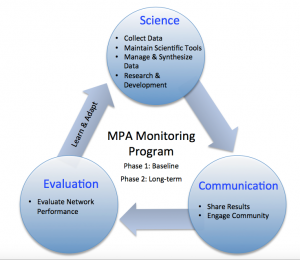California’s MPA Monitoring Program
2022 Updates
Results from the Marine Protected Area (MPA) Network long-term monitoring programs are now available in seven technical reports and one synthesis report developed by a NCEAS working group. These projects represent collaboration between California researchers, the Ocean Protection Council (OPC), California Sea Grant, and the California Department of Fish and Wildlife (CDFW). Each technical report is accompanied by a ‘snapshot’ report, a 2-page summary of each long-term monitoring program highlighting a few of the many key findings found in each technical report. Access the technical reports and snapshot summaries (in English and Spanish) below.
NCEAS MPA Monitoring Synthesis report now available: As part of the Decadal Management Review, and with support from California’s Ocean Protection Council, the National Center for Ecological Analysis and Synthesis (NCEAS) initiated a working group to develop an understanding of how the State of California’s Network of marine protected areas (MPAs) has performed over the past decade, and the lessons those insights provide for future monitoring and management of the network. The primary goal of this MPA analysis and synthesis project is to perform social and ecological analyses using a diverse set of available monitoring data that address critical MPA performance evaluation questions, guided by the MPA Monitoring Action Plan and the recommendations of both the Decadal Evaluation and the Climate Resilience Working Groups, and working in close coordination with long-term MPA monitoring researchers. The working group focused on four main aspects of MPA evaluation: Ecological Performance, Habitat, Climate Resilience, and Human Engagement. Final report is linked below.
MPA Monitoring Webinar Series: Ask the Researcher
OPC in collaboration with CDFW and Strategic Earth developed a summer webinar series to highlight recent results of the MPA monitoring program and give the public an opportunity to connect directly with California MPA scientists. For more information and recordings of past webinars, please visit the Ask the Researcher webpage.

- NCEAS MPA Monitoring Synthesis Report
- California Collaborative Fisheries Research Program
- Technical Report
- Snapshot Summary (English)
- Snapshot Summary (Spanish)
- Human Dimensions: Commercial & CPFV Fishing
- Technical Report & Appendices
- Snapshot Summary (English)
- Snapshot Summary (Spanish)
- Estuaries
- Project Website (Project to be completed in Dec, 2022)
- Snapshot Summary (English)
- Snapshot Summary (Spanish)
- Integrated Ocean Observing Systems
- Technical Report
- Snapshot Summary (English)
- Snapshot Summary (Spanish)
- Kelp Forests
- Technical Report
- Snapshot Summary (English)
- Snapshot Summary (Spanish)
- Mid-Depth Rocky Habitats
- Technical Report
- Snapshot Summary (English)
- Snapshot Summary (Spanish)
- Rocky Intertidal
- Technical Report
- Snapshot Summary (English)
- Snapshot Summary (Spanish)
- Sandy Beach & Surf Zones
- Technical Report
- Snapshot Summary (English)
- Snapshot Summary (Spanish)
MPA Monitoring Program Overview
California is home to the largest scientifically-based, stakeholder-driven network of marine protected areas (MPAs) in the nation, with 124 MPAs that span the coastline and include thousands of species of animals, algae, and plants within a wide diversity of habitats. California’s MPA network was designed through a unique collaboration with stakeholders, managers, scientists, and policy experts to incorporate community input and meet the goals of the Marine Life Protection Act (link is external) (MLPA).
The MPAs reduce or remove fishing pressure, and, where possible, were co-located with Areas of Special Biological Significance (link is external), which have higher water quality standards. The State is tasked with understanding the response of entire ecosystems, not just fished species, to this management action.
To provide information that will help inform adaptive management of the MPA Network, a novel and cost-effective Statewide MPA Monitoring Program was developed, as required by the MLPA. Phase 1 of this program collected regional baseline data at or near the time the MPAs were established. Phase 2 focuses on long-term statewide monitoring and will be guided by the Statewide MPA Monitoring Program Action Plan.
BACK TO the Marine Protected Areas Homepage.


